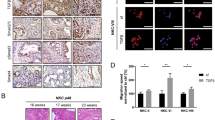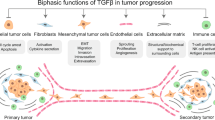Abstract
Transforming growth factor (TGF)-β1 has a biphasic effect on rat intestinal epithelial (RIE) cells. By itself, TGF-β1 functions as a tumor suppressor by inhibiting the growth, migration and invasion of RIE cells. We show in this study that in conjunction with epidermal growth factor (EGF), TGF-β1 helped to augment migration, invasion and anchorage-independent growth (AIG) compared to that by EGF alone. EGF plus TGF-β1 induced a dramatic morphological change characteristic of epithelial–mesenchymal transition (EMT). The mechanism for this enhanced effect of TGF-β1 and EGF on oncogenic properties was explored by analysis of EGF- and TGF-β1-mediated signaling pathways and complementary DNA arrays. TGF-β1 augmented EGF-mediated signaling of mitogen-activated protein kinase (MAPK) and AKT by enhancing and prolonging the activation of the former and prolonging the activation of the latter. Inhibition of MAPK, but not phosphoinositide-3 kinase (PI3K), abolished TGF-β1 plus EGF-induced EMT and downregulation of E-cadherin at mRNA and protein levels. By contrast, cell migration and invasion were sensitive to inhibition of either MAPK or PI3 kinase. TGF-β1 plus EGF-induced AIG was significantly more resistant to inhibition of PI3K and MAPK compared to that induced by EGF alone. EGF and TGF-β1 synergistically induced the expression of a series of proteases including matrix metalloproteinase (MMP) 1 (collagenase), MMP3, MMP9, MMP10, MMP14 and cathepsin. Among them, the expression of MMP1, MMP3, MMP9 and MMP10 was MAPK dependent. Inhibition of the MMPs or cathepsin significantly blocked EGF plus TGF-β1-induced invasion, but had no effect on colony formation. Phospholipase C (PLC) and Cox2 induced by EGF plus TGF-β1 also played a significant role in invasion, whereas PLC was also important for colony formation. Our study reveals specific signaling functions and induction of genes differentially required for enhanced effect of EGF- and TGF-β1-induced oncogenic properties, and helps to explain the tumor-promoting effect of TGF-β1 in human cancer with elevated expression or activation of TGF-β1 and receptor protein tyrosine kinases.
This is a preview of subscription content, access via your institution
Access options
Subscribe to this journal
Receive 50 print issues and online access
$259.00 per year
only $5.18 per issue
Buy this article
- Purchase on Springer Link
- Instant access to full article PDF
Prices may be subject to local taxes which are calculated during checkout






Similar content being viewed by others
References
Assoian RK, Boardman LA, Drosinos S . (1989). A preparative suspension culture system permitting quantitation of anchorage-independent growth by direct radiolabeling of cellular DNA. Anal Biochem 177: 95–99.
Batlle E, Sancho E, Franci C, Dominguez D, Monfar M, Baulida J et al. (2000). The transcription factor snail is a repressor of E-cadherin gene expression in epithelial tumour cells. Nat Cell Biol 2: 84–89.
Blume-Jensen P, Hunter T . (2001). Oncogenic kinase signalling. Nature 411: 355–365.
Bracke ME, Van Roy FM, Mareel MM . (1996). The E-cadherin/catenin complex in invasion and metastasis. Curr Top Microbiol Immunol 213: 123–161.
Cano A, Pérez-Moreno MA, Rodrigo I, Locascio A, Blanco MJ, del Barrio MG et al. (2000). The transcription factor snail controls epithelial–mesenchymal transitions by repressing E-cadherin expression. Nat Cell Biol 2: 76–83.
Cheng GZ, Chan J, Wang Q, Zhang W, Sun CD, Wang LH . (2007). Twist transcriptionally up-regulates AKT2 in breast cancer cells leading to increased migration, invasion, and resistance to paclitaxel. Cancer Res 67: 1979–1987.
Comijn J, Berx G, Vermassen P, Verschueren K, van Grunsven L, Bruyneel E et al. (2001). The two-handed E box binding zinc finger protein SIP1 downregulates E-cadherin and induces invasion. Mol Cell 7: 1267–1278.
de Larco JE, Todaro GJ . (1978). Growth factors from murine sarcoma virus-transformed cells. J Cell Physiol 94: 335–342.
Docherty NG, O'Sullivan OE, Healy DA, Murphy M, O'neill AJ, Fitzpatrick JM et al. (2006). TGF-betal-induced EMT can occur independently of its proapoptotic effects and is aided by EGF receptor activation. Am J Physiol Renal Physiol 290: F1202–F1212.
Fresno Vara JA, Casado E, de Castro J, Cejas P, Belda-Iniesta C, Gonzalez-Baron M. . (2004). PI3K/Akt signalling pathway and cancer. Cancer Treat Rev 30: 193–204.
Glick AB, Lee MM, Darwiche N, Kulkarni AB, Karlsson S, Yuspa SH . (1994). Targeted deletion of the TGF-beta 1 gene causes rapid progression to squamous cell carcinoma. Genes Dev 8: 2429–2440.
Gold LI . (1999). The role for transforming growth factor-beta (TGF-beta) in human cancer. Cri Rev Oncog 10: 303–360.
Itoh Y, Nagase H . (2002). Matrix metalloproteinases in cancer. Essays Biochem 38: 21–36.
Jong SM, Wang L-H . (1987). The transforming protein P68gag-ros of avian sarcoma virus UR2 is a transmembrane protein with the gag portion protruding extracellularly. Oncogene Res 1: 7–21.
Kizaka-Kondoh S, Akiyama N, Okayama H . (2000). Role of TGF-beta in EGF-induced transformation of NRK cells is sustaining high-level EGF-signaling. FEES Lett 466: 160–164.
Massagué J, Blain SW, Lo RS . (2000). TGFbeta signaling in growth control, cancer, and heritable disorders. Cell 103: 295–309.
Nguyen KT, Wang WJ, Chan JL, Wang LH . (2000). Differential requirements of the MAP kinase and PI3 kinase signaling pathways in Src- versus insulin and IGF-1 receptors-induced growth and transformation of rat intestinal epithelial cells. Oncogene 19: 5385–5397.
Sachdev P, Zeng L, Wang L-H . (2002). Distinct role of phosphatidylinositol 3-kinase and Rho family GTPases in Vav3-induced cell transformation, cell motility, and morphological changes. J Biol Chem 277: 17638–17648.
Saha D, Datta PK, Sheng H, Morrow JD, Wada M, Moses HL et al. (1999). Synergistic induction of cyclooxygenase-2 by transforming growth factor-betal and epidermal growth factor inhibits apoptosis in epithelial cells. Neoplasia 1: 508–517.
Seton-Rogers SE, Lu Y, Hines LM, Koundinya M, LaBaer J, Muthuswamy SK et al. (2004). Cooperation of the ErbB2 receptor and transforming growth factor beta in induction of migration and invasion in mammary epithelial cells. Proc Natl Acad Sci USA 101: 1257–1262.
Siegel PM, Shu W, Cardiff RD, Muller WJ, Massague J . (2003). Transforming growth factor beta signaling impairs Neu-induced mammary tumorigenesis while promoting pulmonary metastasis. Proc Natl Acad Sci USA 100: 8430–8435.
Stolz DB, Michalopoulos GK . (1997). Synergistic enhancement of EGF, but not HGF, stimulated hepatocyte motility by TGF-beta 1 in vitro. J Cell Physiol 170: 57–68.
Tang B, Bottinger EP, Jakowlew SB, Bagnall KM, Mariano J, Anver MR et al. (1998). Transforming growth factor-beta1 is a new form of tumor suppressor with true haploid insufficiency. Nat Med 4: 802–807.
Thiery JP . (2003). Epithelial–mesenchymal transitions in development and pathologies. Curr Opin Cell Biol 15: 740–746.
Uttamsingh S, Zong CS, Wang L-H . (2003). Matrix-independent activation of phosphatidylinositol 3-kinase, Stat3, and cyclin A-associated Cdk2 Is essential for anchorage-independent growth of v-Ros-transformed chicken embryo fibroblasts. J Biol Chem 278: 18798–18810.
Wang LH . (2004). Molecular signaling regulating anchorage-independent growth of cancer cells. Mt Sinai J Med 71: 361–367.
Welch DR, Fabra A, Nakajima M . (1990). Transforming growth factor beta stimulates mammary adenocarcinoma cell invasion and metastatic potential. Proc Natl Acad Sci USA 87: 7678–7682.
Yan C, Boyd DD . (2007). Regulation of matrix metalloproteinase gene expression. J Cell Physiol 211: 19–26.
Acknowledgements
We thank Dr J Cheng of University of South Florida for the gift of AKT inhibitor AP1-2 and Dr Weizhou Zhang for artwork of the figures. We apologize to our many colleagues for not being able to cite their studies due to space limitation. This work was supported by NIH Grants CA29339 and CA55054 and DOD Grant DAMD 17-02-01-0504/BC11101.
Author information
Authors and Affiliations
Corresponding author
Additional information
Supplementary Information accompanies the paper on the Oncogene website (http://www.nature.com/onc).
Supplementary information
Rights and permissions
About this article
Cite this article
Uttamsingh, S., Bao, X., Nguyen, K. et al. Synergistic effect between EGF and TGF-β1 in inducing oncogenic properties of intestinal epithelial cells. Oncogene 27, 2626–2634 (2008). https://doi.org/10.1038/sj.onc.1210915
Received:
Revised:
Accepted:
Published:
Issue Date:
DOI: https://doi.org/10.1038/sj.onc.1210915
Keywords
This article is cited by
-
Deduction of signaling mechanisms from cellular responses to multiple cues
npj Systems Biology and Applications (2022)
-
Numb-PRRL promotes TGF-β1- and EGF-induced epithelial-to-mesenchymal transition in pancreatic cancer
Cell Death & Disease (2022)
-
Desuppression of TGF-β signaling via nuclear c-Abl-mediated phosphorylation of TIF1γ/TRIM33 at Tyr-524, -610, and -1048
Oncogene (2019)
-
Heparin-binding epidermal growth factor (HB-EGF) drives EMT in patients with COPD: implications for disease pathogenesis and novel therapies
Laboratory Investigation (2019)
-
New insights into the mechanisms of epithelial–mesenchymal transition and implications for cancer
Nature Reviews Molecular Cell Biology (2019)



